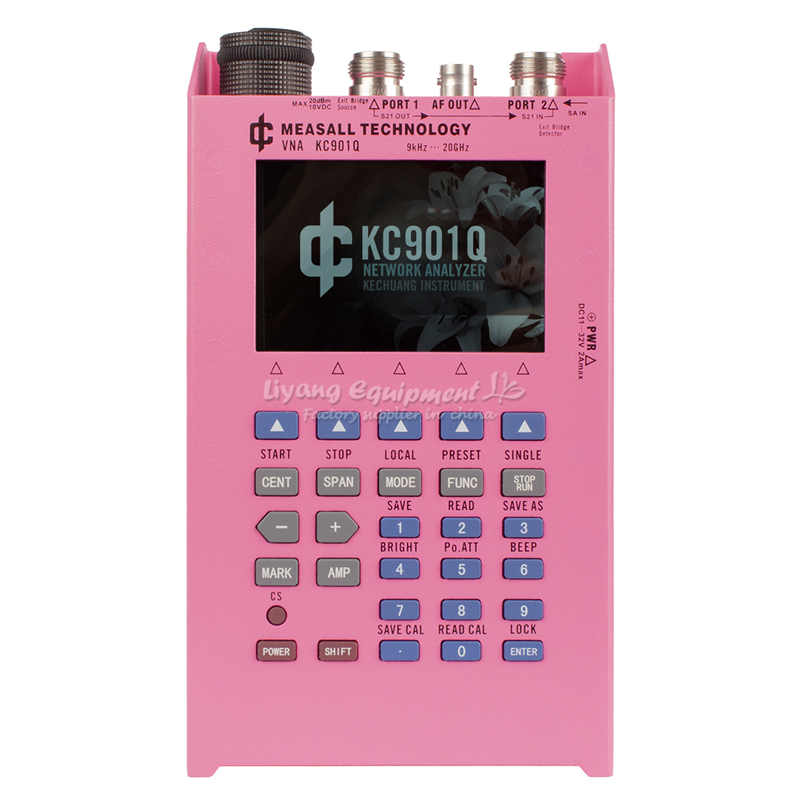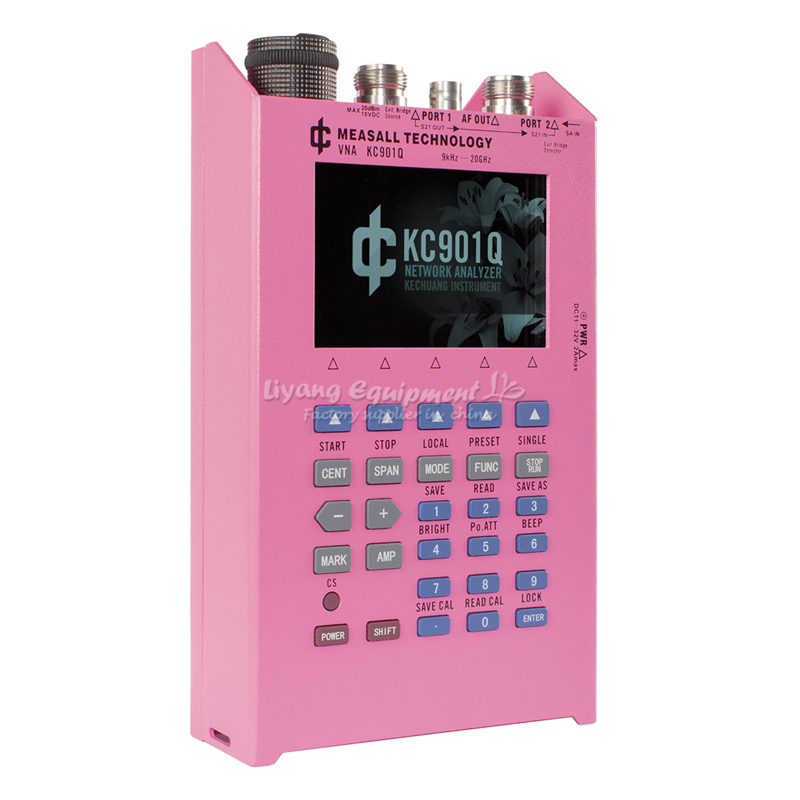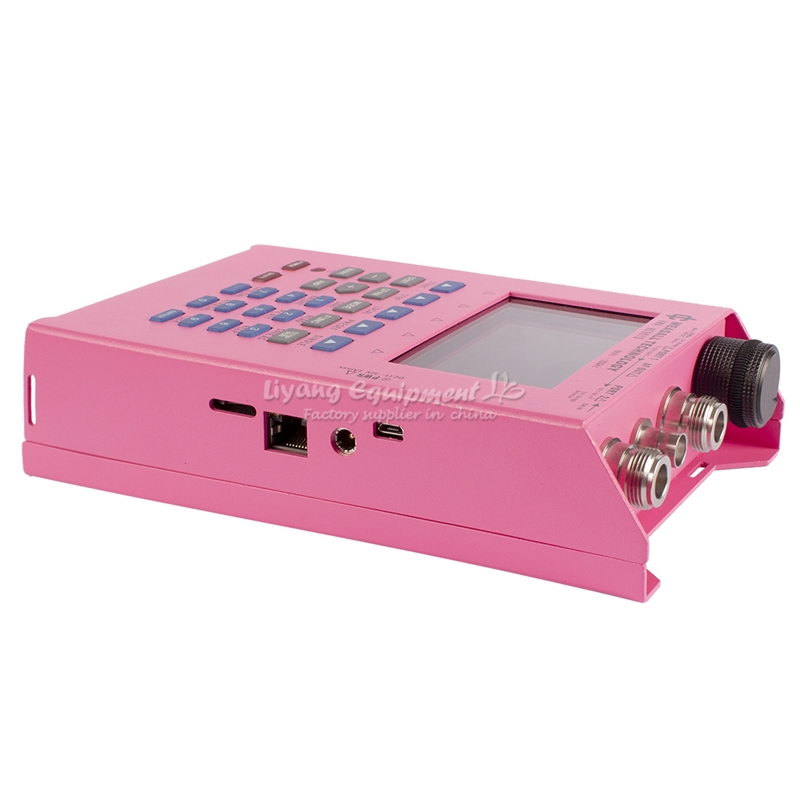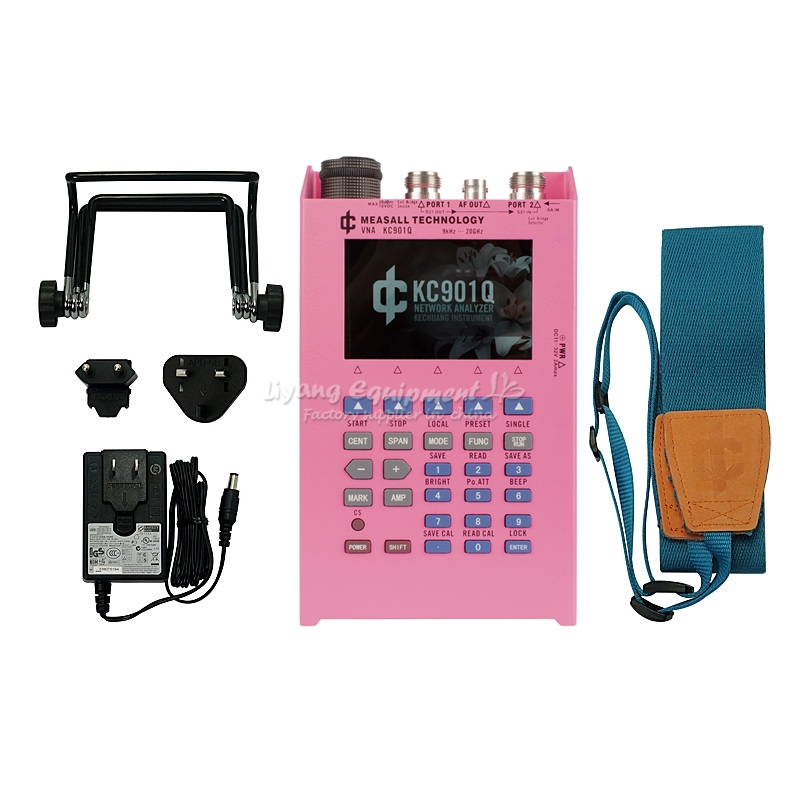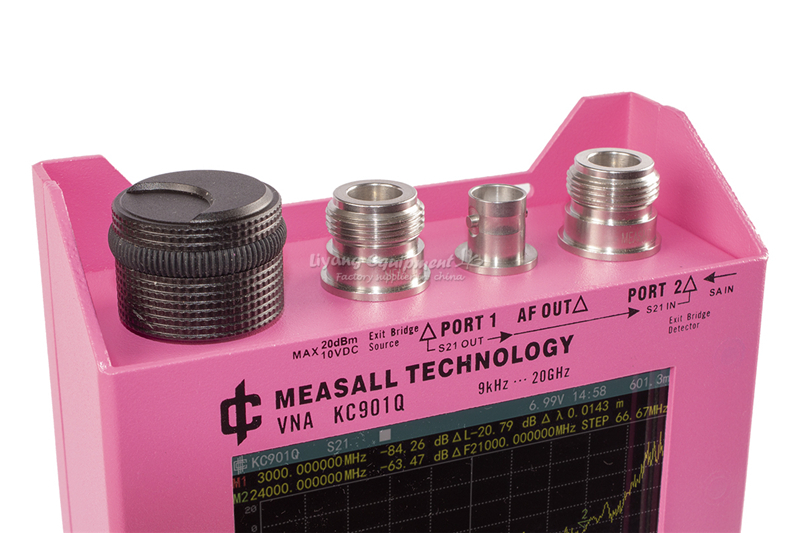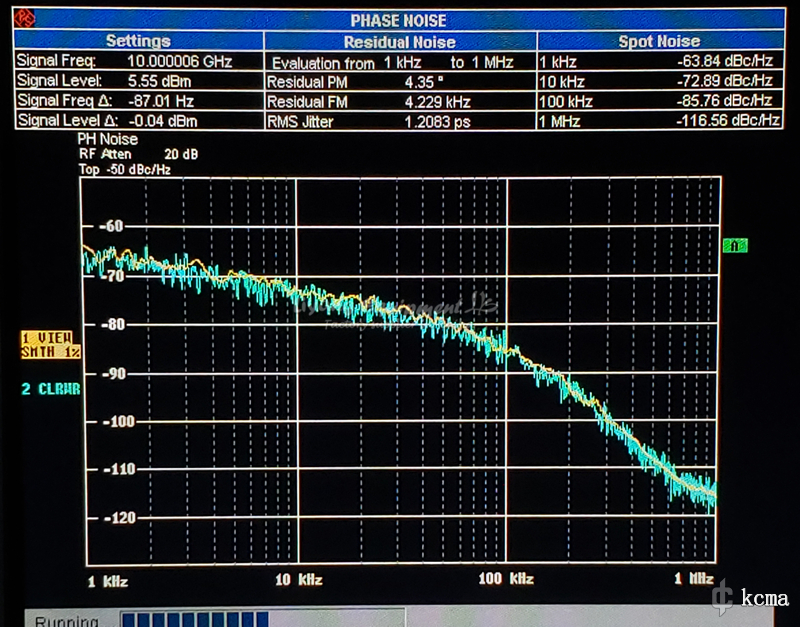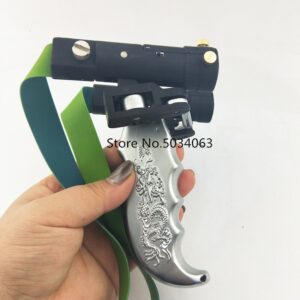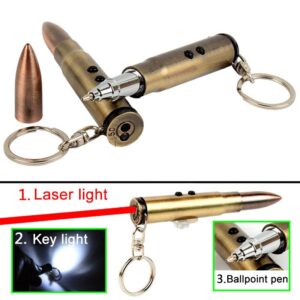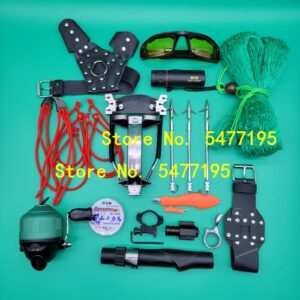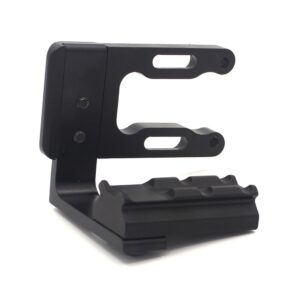Description
- Brand Name: HKNA
- Origin: CN(Origin)
- Certification: CE
- Product name: KC901Q 20GHz Handheld vector network analyzer tester
- After-sales Service Provided: Engineers available to service machinery overseas
- Type: VNA
KC901Q 20GHz Handheld Network vector tester RF multimeter without built-in bridge sweeper sweep generator




 The KC901Q is a vector sweeper. He is able to measure the amplitude and phase changes that occur after the signal passes through the device, while extending the spectrum, field strength, and signal generator functions, adding practicality to form a RF multimeter.
The KC901Q is a vector sweeper. He is able to measure the amplitude and phase changes that occur after the signal passes through the device, while extending the spectrum, field strength, and signal generator functions, adding practicality to form a RF multimeter.
The KC901Q uses the basic architecture of the KC901x. However, the KC901Q does not have a built-in bridge. The basic function is the sweeper (providing amplitude and phase), which is significantly different from other instruments in the KC901 series.
The KC901Q can perform vector reflection measurements with an external bridge or directional coupler. The instrument has a built-in full-port calibration model that supports OSL calibration. Sweep measurements support response calibration (amplitude and phase).
*Main Features*
20GHz frequency range
1Hz frequency stepping
Good accuracy and stability
Double frequency conversion, strong anti-interference ability
Rich in function and easy to carry
*Main function
Sweep test (get amplitude difference, phase difference)
Reflection test (external directional coupler required)
Low frequency and RF signal sources**
Spectrum display and field strength observation**
*Recommended application
The KC901Q is mainly used to debug various RF circuits, such as filters, amplifiers, splitters, combiners, external directional couplers or standing wave bridges, to test the input and output impedance, and to evaluate the quality of the antenna system. With its receiver, it can also detect the signal amplitude of each level of the equipment, and perform field strength measurement and interference search in some frequency bands.
KC901Q is a good tool for learning RF knowledge. In the professional field, it can be used in the fields of communication engineering, antenna manufacturing, and routine maintenance such as radar, microwave stations, satellite earth stations, and radio astronomy stations.
The following scenarios may not apply:
The spectrum and field strength functions are not suitable for measuring pulse and wideband signals (eg radar, WIFI, Bluetooth), frequency hopping signals. In some cases, qualitative observations can be completed by experienced engineers, but we cannot guarantee that every user can complete it.
Any test should not have strong interfering signals in the 109-110MHz range. Some broadcast transmitting stations have 109MHz spurs. If the antenna is measured near the transmitting station, it will affect the accuracy of the instrument.
* Please read the technical manual
** Informal features
*Working principle
The basic principle of the KC901Q is similar to other products in the KC901x family, but it does not have a built-in bridge.
The basic principle of the instrument is that the RF signal source produces a measurement signal, which is sampled from the instrument 1 port after being sampled by the forward splitter. After the measurement signal passes through the device under test, it is input from the instrument 2 port, detected by the receiver, and compared with the signal sample obtained from the 1 port.
The signal source is divided into three frequency bands: signals below 60MHz are generated by a direct digital synthesizer (DDS); signals above 60MHz and below 7GHz are generated by a phase-locked loop frequency synthesizer (PLL) and passed through an attenuator; The signal is multiplied and does not pass through the attenuator. The signals of the three frequency bands are gated through the RF switch and combined into one RF signal output.
The figure below is a block diagram of the KC901Q. The machine has two phase-locked loop frequency synthesizers with frequency dividers covering the range of 60MHz-15GHz. The circuit can work normally to 26.5 GHz until 30 GHz still has a weak output, but above 24 GHz, the indicator has rapidly deteriorated.
There are two receivers inside the instrument, and the local oscillator is provided by the same phase-locked loop frequency synthesizer. One of the receivers detects the output signal of port 1 through the internal circuitry of the instrument. The other receiver is connected to port 2 to detect external inputs. By comparing the amplitude and phase of the two receivers, the amplitude difference and phase difference between Port 1 and Port 2 can be obtained.
The instrument uses 7GHz as the breakpoint. Below 7GHz, the signal does not pass through the frequency multiplier and is output through the adjustable attenuator. The PLL outputs a signal of 3.5 GHz to 15 GHz, and a signal of 7-30 GHz is obtained by a frequency multiplier. Since the adjustable attenuator supporting 30 GHz is slightly more expensive, the application requirements of the integrated trade-off products have no built-in attenuators at frequencies above 7 GHz.
KC901Q uses secondary frequency conversion, the first intermediate frequency is 109.65MHz, and the second intermediate frequency is 350KHz. The second intermediate frequency is digitized by the synchronous sampling ADC and sent to the FPGA for subsequent digital processing.
The DDS in the machine can be directly output to form an audio signal source.
Since the KC901Q does not have a built-in bridge, an external directional device is required to measure the reflection parameters. An equal arm or unequal arm Wheatstone bridge can be used in the lower frequency band, and a directional coupler is preferred in the higher frequency band. Directional couplers can be made or purchased based on common frequency ranges. This type of coupler is inexpensive and reduces the cost of the package. The connection between the directional coupler and the instrument should be as short as possible, preferably with a semi-steel wire connection of no more than 20 cm in length.
The KC901Q does not have S11 factory calibration data due to the absence of a built-in bridge. After the external directional bridge is attached, calibration must be performed. If a bridge or coupler is often used, system calibration can be done for them for future use. If it is only a temporary measure, only user calibration can be performed. A disadvantage of user calibration is that once the frequency is changed, the calibration fails.
*Technical specifications
The basic technical specifications of the 901Q are as follows (the products may be slightly different in different periods):
project
Test Condition
parameter
Remarks
lowest
typical
highest
Frequency Range
Spectrum/transmission
Effective
9kHz
20GHz
Settable
0
30GHz
Frequency Range
(reflection)
Effective
Depending on the external orientation device in the 5kHz-20GHz range
Settable
5kHz
30GHz
Scanning range
SPAN
1KHz
29.99GHz
Scan points
450pt
3150pt
Local operation
Frequency resolution
All scanning functions
1Hz
Low frequency signal source
0.1Hz
Level resolution
0.01dB
Phase resolution
0.01°
Scanning speed
RBW=30KHz, every point
1.2ms
RBW=10KHz, every point
1.5ms
RBW=3KHz, every point
2.4ms
RBW=1KHz, every point
4ms
RBW=30K, 450pt per screen
0.6s
Output level
Scan mode
1MHz-7GHz
-10dBm
6dBm
10dB
7GHz-20GHz
-13dBm
0dBm
6dBm
20GHz-26GHz
-20dBm
-13dBm
-6dBm
No guarantee
Maximum output level
1MHz-7GHz signal source
3dBm
10dBm
13dBm
7GHz-20GHz signal source
-13dBm
0dBm
6dBm
Output attenuation
9kHz-7GHz
0dB
25dB
Note 2
Sensitivity
1MHz-7GHz
-101dBm
-107dBm
-113dBm
Port 2
RBW=1KHz
7GHz-15GHz
-98dBm
-104dBm
-110dBm
15GHz-22GHz
-95dBm
-101dBm
The available dynamic range of the transmission measurement
1MHz-1GHz
95dB
100dB
Equivalent to transceiver channel isolation
Note 3
1GHz-2GHz
85dB
90dB
2GHz-15GHz
70dB
15GHz-24GHz
60dB
24GHz-26.5GHz
40dB
Amplitude uncertainty of transmission measurement
1MHz-20GHz
After straight-through calibration, when the insertion loss is L<40dB
0.5+0.1L
Note 4
Zero offset drift of insertion loss
When the existing insertion loss of compensation is L<30dB, 1MHz-15GHz
0.1dB
Preheated for 5 minutes
Directional device directivity is better than 15dB, directionality after calibration
9kHz-7GHz
45dB
An external orientation device is required.
7GHz-15GHz
40dB
15GHz-20GHz
35dB
20GHz-26GHz
25dB
USBearth business group is located in Shenzhen, China.
Our factory owns 2 brands , Ly and Bauer , and Shuttle,ZM,KIDI,HonTon … Factory agent .
We has 10 years experiences in manufacturing and foreigh trade
Our BGA rework stations , such Ly IR6000, Ly IR6500, Ly IR9000,Ly IR-PRO-SC, Ly IR8000, Ly HR560, Ly HR560C, Ly HR500, Ly SV550C, Bauer IR-PRO-SCC ,Bauer OMEGA XD …
CNC machines like cnc 3020/4030/6040/9060 …series products ,Mobile LCD separating stationslike 946D /947B /950V/948V/948B…are hot sale in the world, especially in these countries from North and South American,European and Asian.


